Gone are the days of harsh cleansers that dried out your skin – everyone’s getting into gentle cleansers! What’s the science behind gentle cleansing, and how do you pick a gentle cleanser?
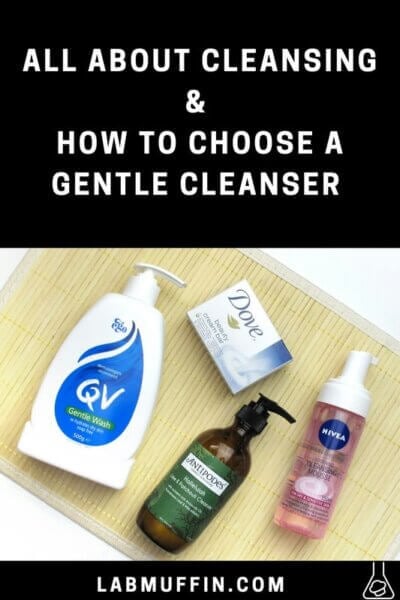
Here’s the scientific background behind this skin-loving trend!
Want more about the science behind choosing and using the right cleansers, moisturiser and sunscreen for your skin? Check out The Lab Muffin Guide to Basic Skincare!
Related Post: The Lab Muffin Guide to Basic Skincare
How Cleansing Damages Your Skin
Cleansing is the most damaging thing you do to your skin on a daily basis. But unfortunately it’s necessary to get rid of all the dirt, makeup, oil and sunscreen you’ve accumulated on your skin over the course of the day.
These unwanted substances won’t come off with water though! That’s why cleansers usually contain surfactants, magical ingredients which can help the grime dissolve in water and wash away.
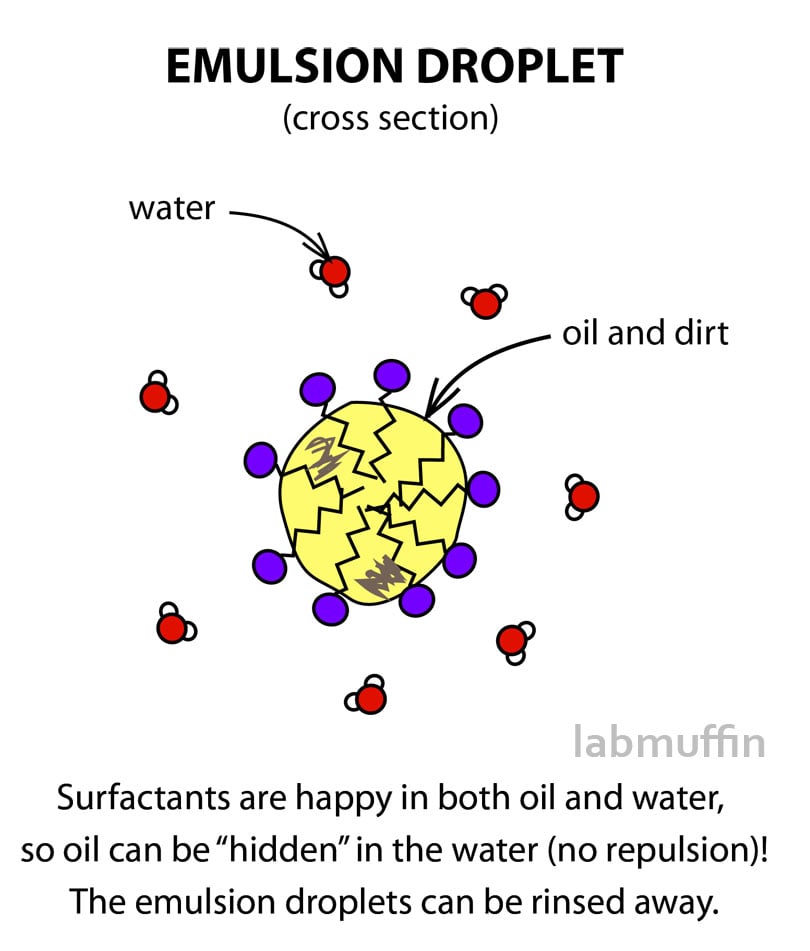
Surfactants are the key ingredients in pretty much every single cleanser: foaming cleansers, soaps, body washes, cleansing balms, cleansing oils and micellar water.
In fact, the only common surfactant-free cleansing methods I can think of are oil cleansing and using a cloth with just water. (I wrote about how surfactants are in everything in this post).
Related Post: Surfactants Are Everywhere, aka Stop Being Terrified of Chemicals
As amazing and useful as surfactants are at lifting grime, they’re not always good for your skin. The outer layer of your skin (the stratum corneum, SC or, ahem, “horny layer” – also commonly referred to as your skin barrier) consists of dead, protein-rich skin cells filled with water-binding chemicals (your natural moisturising factor or NMF). These cells are surrounded by carefully arranged oily lipids (mostly ceramides, cholesterol and fatty acids).
Related Post:Are You Washing Your Face Wrong? Busting Cleanser Myths (with video)
It looks a lot like a brick wall, with skin cells as bricks and oily lipids as mortar.
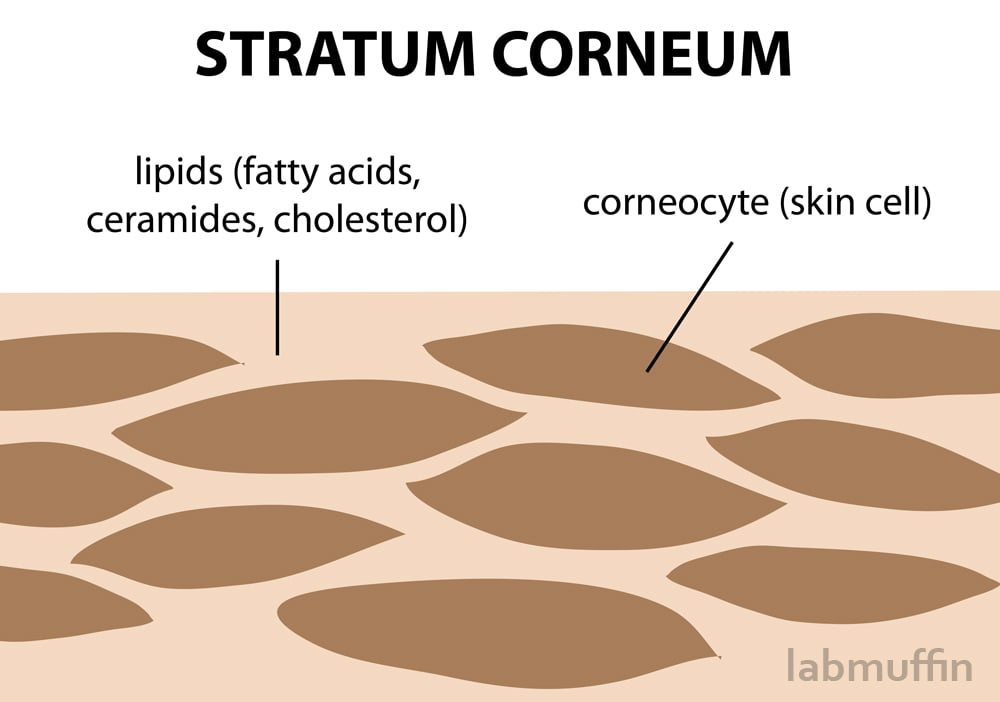
Together, these components form a barrier against water evaporating from the skin into the environment, and against external irritants entering your skin.
When the stratum corneum’s structure is disturbed, skin becomes dry, itchy, flaky, red and irritated.
Luckily, the stratum corneum is pretty hardy and holds up well against most things… but unfortunately, surfactants are VERY good at messing things up!
Here’s how a harsh cleanser disturbs your skin:
Removes important stratum corneum components
Surfactants are amazing at removing grime, but they can’t tell the difference between the chemicals that make up your skin and the chemicals that aren’t meant to be there.
Surfactants are good at removing lipids (particularly cholesterol) from your stratum corneum, which messes up its structure and makes it more susceptible to water loss.
They also remove proteins and NMF components from your skin, meaning it won’t be able to hold onto water as effectively.
This all leads to dry, dehydrated skin.
Related post: Is Your Skin Dry or Dehydrated? And How to Treat It
Remains in the skin, causing irritation and disruption
After cleansing, most of the surfactant gets rinsed off, but unfortunately not all of it.
Some surfactant molecules will bind to proteins in the skin, causing them to denature (change shape) and swell. The more swelling, the greater the irritation. (Interestingly, this interaction with proteins is probably a bigger contributor to the “tight” feeling after cleansing than the loss of oils!)
Additionally, surfactants can remain in the lipid “mortar” of the stratum corneum, changing its structure.
Together, these effects lead to a compromised skin barrier that’s prone to letting water escape and irritants enter.
Related post: Barrier Repair, Rosacea, Sensitive Skin: Products & Tips
Changes the pH of skin
Skin is acidic, meaning it has a low pH that’s somewhere around pH 5. This is important because a lot of the biochemical reactions that occur in skin work best within a narrow pH range.
Surfactant-containing cleansers are particularly good at changing skin pH for long amounts of time, meaning that if your cleanser has a particularly high pH, then it can hinder your skin from repairing itself. High pH can also make skin swell and reduce its flexibility.
If you’re acne-prone, there’s more bad news: high pH encourages the growth of acne-worsening Cutibacterium acnes bacteria (more on pH and bacteria in this post from Snow White and the Asian Pear).
Picking a Gentle Cleanser
A good cleanser will clean grime off your face while keeping your skin relatively intact. It’s difficult to tell just from the ingredients whether a cleanser will be gentle, but here are a few things to look out for:
Specific surfactants
The surfactants a cleanser contains makes the biggest difference in terms of how damaging it is.
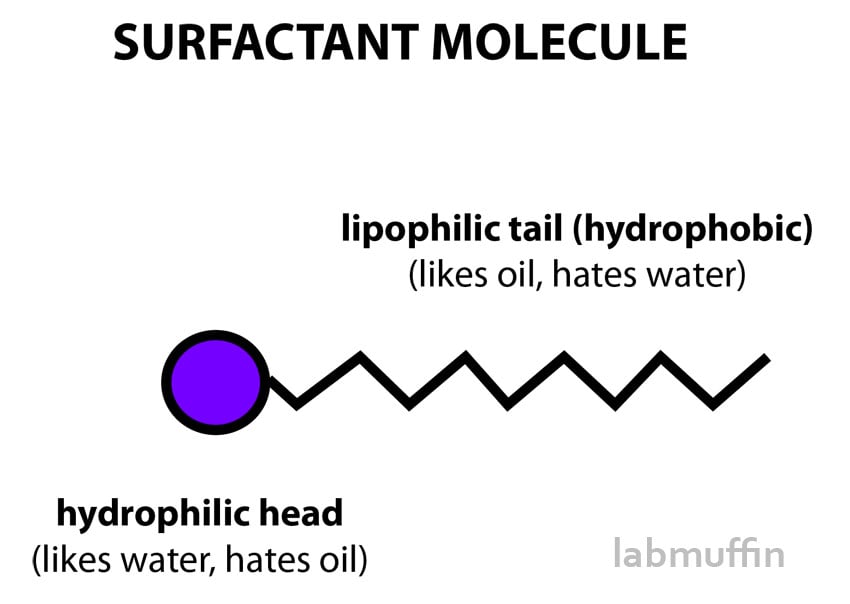
Surfactants with small, negatively charged (anionic) head groups and tails 10-14 carbons long are particularly harsh. Larger head groups, uncharged (non-ionic) or neutrally charged (amphoteric/zwitterionic) heads and different tail lengths are milder.
Harsh surfactants with both these characteristics include:
- many soaps (e.g. “sodium XXate” – sodium laurate, sodium cocoate, sodium tallowate)
- sodium lauryl sulfate (aka SLS)
Milder surfactants that are much gentler on skin include:
- sodium laureth sulfate (SLES), especially in combination with cocoamidopropyl betaine (CAPB)
- sodium cocoyl isethionate
- alkyl sulfosuccinates (“XX succinate” in an ingredients list)
- alkyl sarcosinates
However, there are other formulating techniques that can make even a traditionally harsh surfactant like SLS gentler!
Multiple surfactants
There’s also research showing that mixtures of surfactants make for gentle cleansers.
Surfactants assemble into spherical micelles in solution. If a micelle is very small, it penetrates more easily into skin, causing irritation. Mixtures of surfactants tend to form larger micelles and hence reduce irritation. (You can read more about this phenomenon on KindofStephen.)
Additionally, due to entropic effects, a “messy” micelle with more different surfactants is usually better at staying together than a micelle made up of a single surfactant. This means individual surfactant molecules are less likely to run off into your skin.
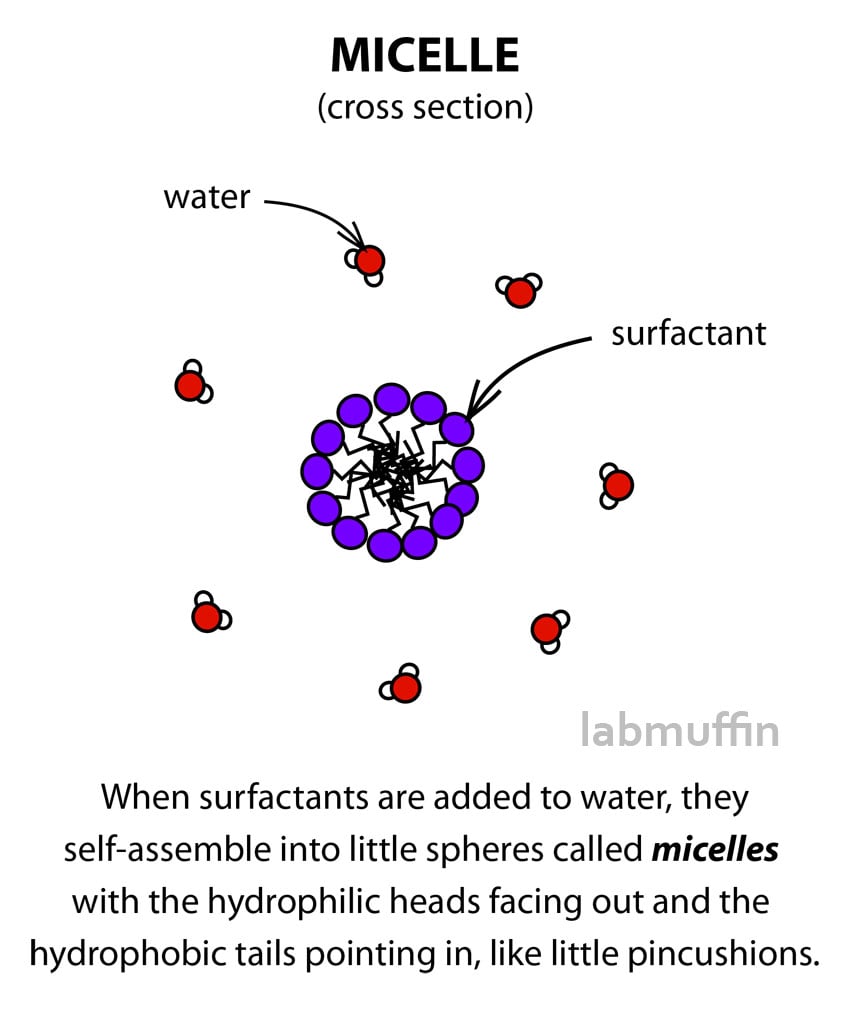
So for a milder cleanser, look for multiple of the above surfactants near the top of the ingredients list.
Foam?
Interestingly, more foam doesn’t necessarily mean a harsher cleanser! Traditionally, foaming cleansers were made with SLS, but there are a few methods of formulating cleansers to foam while still being gentle.
For example, in some tests, low-foaming cleansers were more drying than foaming cleansers containing moisturising emollient ingredients.
Related Post: Do I Need a Special Cleanser to Remove Sunscreen?
pH
As discussed above, high pH cleansers are more damaging, so cleansers with a lower pH (less than 6) can be gentler. Unfortunately, most cleansers don’t tell you their pH, so you’ll have to do a bit of Googling or buy some pH test strips (universal indicator strips like these are very cheap, multi-square strips like these are a bit more precise though).
To preserve the pH of your skin, it’s a good idea to avoid traditional “natural” soaps. Soap surfactants don’t work at pHs lower than about 9.5, which means they can’t be formulated to be as mild as other surfactant systems, no matter how natural they seem.
Moisturising ingredients
Cleansers often incorporate moisturising ingredients like oils and humectants to replace what’s been stripped from the skin during cleansing.
Look for oils like sunflower oil and mineral oil, fatty acids like stearic acid, other lipids like ceramides and cholesterol, and humectants like glycerin and sorbitol in your cleansers.
Antioxidants and soothing ingredients
The inclusion of ingredients that soothe skin during cleansing can also cut down on irritation. Common ingredients you’ll see in cleansers include vitamin E (tocopherol), allantoin, bisabolol, panthenol and niacinamide.
Other tips for gentle cleansing
- Use cooler water: I know it’s hard in winter, but hotter water increases the ability of surfactants to penetrate the skin and increases the stripping of lipids, proteins and NMF from your skin.
- Use less cleanser: The less cleanser that touches your skin, the less damage you’ll get.
- Don’t let it soak: The longer the cleanser stays in contact with your skin, the more time it’ll have to penetrate into your skin. Don’t let it stay on your skin for too long.
- Cleanse less frequently: If you wash your skin with cleanser more than once a day, see if you can cut down. In the morning, if you’ve cleansed sufficiently the night before, you can just splash water on your face and pat it off.
- Remove surfactant from your skin afterwards: Wipe-off products (e.g. micellar water, cleansing wipes) usually contain mild surfactants that can be left on the skin, but depending on the product, they can still cause irritation. If you don’t want to do a full rinse, wiping with a damp tissue or cotton pad can help.
- Follow up with moisturiser: Add water, emollients and humectants back into your skin with a moisturising product.
Related post: How to Choose a Moisturizer: The Science
My gentle cleansing routine
Since I have oily skin, I tend not to worry too much about what cleansers I use in summer. In winter, however, my skin is very prone to dehydration (read about what dehydrated skin means here), so I have the annoying task of trying to find gentle cleansers that can effectively remove all my makeup and sunscreen without making me itchy.
Related Post: Is Your Skin Dry or Dehydrated? And How to Treat It
Here are some gentle cleansers I’ve been using to try to limit the damage:
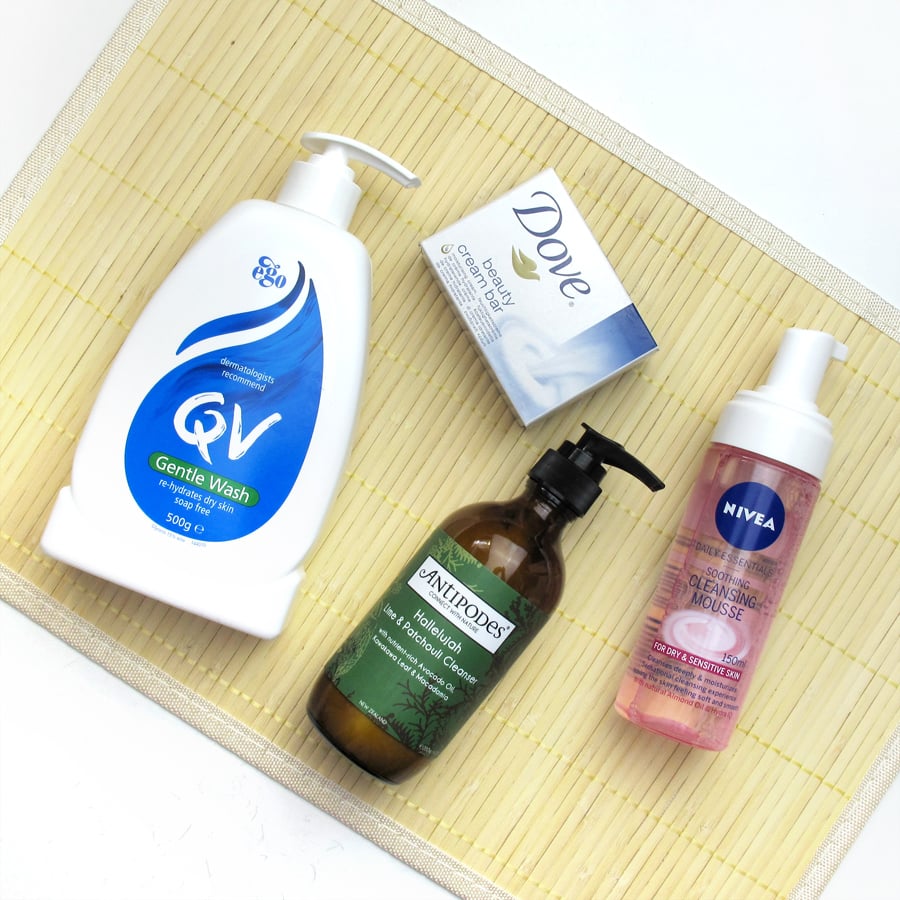
QV Gentle Wash
QV is a brand that a lot of doctors recommend for sensitive skin, and QV Gentle Wash is one of their star products. The packaging and scent are boring, but it’s extremely gentle, with 15% glycerin to keep your skin hydrated, and a blend of mild surfactants that won’t irritate your skin much.
It also contains some polymers, which thicken the product and can potentially help reduce skin penetration of surfactants. I found that it left my skin feeling clean but not tight, and the itch I usually get from winter showers has disappeared.
If you’re into bulk savings, a 1 kg bottle of QV Gentle Wash is about $20 AUD. QV also has an Intensive Cleanser which has a whopping 60% glycerin for even gentler cleansing.
Pros:
- Lots of water-restoring glycerin
- Mix of gentle surfactants
- Fragrance free
- Handy hygienic packaging
- Budget-friendly (~$20 AUD for 1 kg)
Cons:
- A bit boring
- No emollients to replace lost oil-based skin components
Ingredients: Aqua (Water), Glycerin, Sodium Lauroyl Sarcosinate, Disodium Cocoamphodiacetate, Lauryl Betaine, Sodium Cocoyl Isethionate, Acrylates/ C10-30 Alkyl Acrylate Crosspolymer, Styrene/Acrylates Copolymer, Aminomethyl Propanol, Methylparaben, Propylparaben.
Dove Beauty Cream Bar
My other favourite body cleanser is Dove’s Beauty Cream Bar. It markets itself as containing 1/4 cream moisturiser, with lots of oily moisturising ingredients like stearic acid and lauric acid, which are good at sticking to skin and won’t rinse off.
It does have a bunch of soaps in the ingredients list (sodium palmitate/stearate/palm kernelate), but since the pH of the bar is 7, they’ve probably been converted back into the fatty acids which will moisturise rather than strip skin.
The other main surfactants (sodium lauroyl isethionate, sodium isethionate, cocamidopropyl betaine) are well known for being gentle. I found that my skin felt more moisturised than with QV Gentle Wash, but since I’m pretty clumsy, I kept dropping it and knocking it out of my soap dish.
Pros:
- Lots of emollient moisturisers
- Gentle surfactants
- No parabens (only a problem if you’re allergic)
- Budget-friendly
Cons:
- Scented
- Can feel a little heavy
- pH is a bit high
- Bar is less hygienic than liquid
Sodium Lauroyl Isethionate, Stearic Acid, Sodium Palmitate, Lauric Acid, Aqua, Sodium Isethionate, Sodium Stearate, Cocamidopropyl Betaine, Sodium Palm Kernelate, Glycerin, Parfum, Sodium Chloride, Zinc Oxide, Tetrasodium EDTA, Tetrasodium Etidronate, Alumina, Alpha-Isomethyl Ionone, Benzyl Alcohol, Butylphenyl Methylpropional, Citronellol, Coumarin, Hexyl Cinnamal, Limonene, Linalool, CI 77891.
Hada Labo Gokujyun Super Hyaluronic Face Foam
Hada Labo Gokujyun Super Hyaluronic Face Foam is one of my favourite cleanser recommendations. It comes in a self-foaming pump which is perfect for my laziness, plus I find that it makes the product last longer than if I doled it out myself.
It contains a lot of humectant hyaluronic acid, as well as emollient fatty acids to moisturise the skin, though it doesn’t feel like it leaves a residue.
The surfactants are super gentle. I was quite surprised at how effective it was, even though it felt super mild – one pump was enough to get rid of all my everyday make-up.
Pros:
- Contains humectants and emollient moisturisers
- Gentle surfactants
- Effective
- Handy self-foaming pump
- Doesn’t feel heavy
- Reasonably priced
Cons:
- May not be strong enough for heavy make-up
Water, Butylene Glycol, Isopentyldiol, Lauryl Glucoside, Cocamide DEA, Lauric Acid, PEG-80 Sorbitan Laurate, Sodium Lauroyl Methyl Alanine, Hydroxypropyl Trimonium Hyaluronate, Sodium Acetyl Hyaluronate, Sodium Hyaluronate, Isomerized Sugar, Pentylene Glycol, Polyquaternium-7, Palmitic Acid, Myristic Acid, Hydroxylated K TEA EDTA-2Na, BHT, Sodium Pyrosulfite, Phenoxyethanol
Bioderma Sensibio H2O Micelle Solution
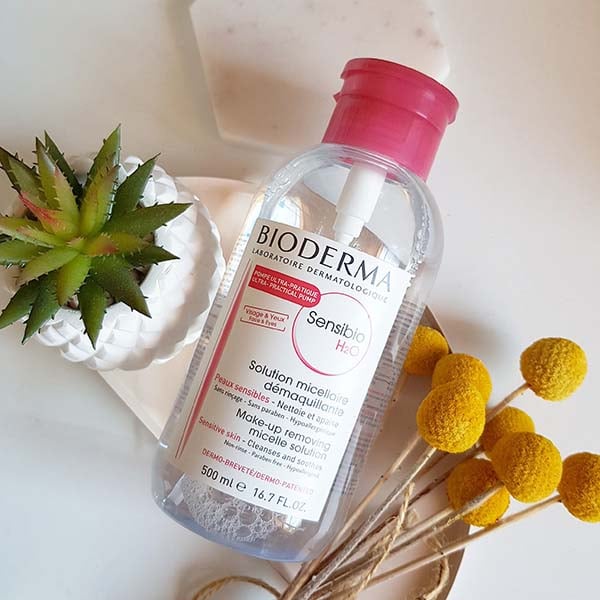
Bioderma Sensibio H2O Micelle Solution was the first micellar water on the market. It was specifically designed as a no-rinse cleanser to be used in areas where the tap water was too hard and caused irritation, and was developed with extensive clinical testing on sensitive skin.
It uses a surfactant traditionally used in leave-on products and as a mildness additive to regular cleansers (PEG-6 caprylic/capric glycerides). It’s also formulated with soothing humectant ingredients that support the skin barrier (cucumber extract, mannitol, xylitol, rhamnose, fructooligosaccharides).
I’ve been using this on nights when I feel lazy, as well as mornings when my perioral dermatitis has been flaring. I find that my skin is perfectly happy after using this, even without rinsing!
The roughness of the cotton pad you use can make a difference to how gentle it is – I recommend using reusable cotton pads.
Pros:
- Very gentle (developed specifically for sensitive skin)
- Convenient
- Travel-friendly (don’t need to rinse)
Cons:
- Need to have cotton pads (although you can use it like a rinse-off cleanser too, but you lose the convenience)
Water (Aqua), PEG-6 Caprylic/Capric Glycerides, Cucumis Sativus (Cucumber) Fruit Extract, Mannitol, Xylitol, Rhamnose, Fructooligosaccharides, Propylene Glycol, Disodium EDTA, Cetrimonium Bromide.
Heimish All Clean Balm
Heimish All Clean Balm is a cleansing balm that’s excellent for breaking down water resistant makeup and sunscreen. While this isn’t a necessary step in cleansing, and many regular cleansers can remove enough, a cleansing balm does feel very relaxing to massage on!
This is one of the most budget-friendly cleansing balms on the market, and rinses off cleanly. You may want to follow up with a second cleanser if there’s a lot of makeup residue on your skin.
Pros:
- Very effective at removing makeup
- Rinses off cleanly
Cons:
- Lightly fragranced with essential oils (only a problem if you’re sensitive to essential oils)
- Minor concerns with microplastic content (texturing microplastics from cosmetic products don’t seem to be a big source of environmental microplastics, but you might want to avoid them anyway)
Ethylhexyl Palmitate, Cetyl Ethylhexanoate, PEG-20 Glyceryl Triisostearate, Polyethylene, PEG-8 Isostearate, 1,2-Hexanediol, Butyrospermum Parkii (Shea) Butter, Citric Acid, Citrus Aurantium Dulcis (Orange) Peel Oil, Lavandula Angustifolia (Lavender) Oil, Pelargonium, Graveolens Flower Oil, Amyris Balsamifera Bark Oil, Citrus Paradisi (Grapefruit) Peel Oil, Eucalyptus Globulus Leaf Oil, Melaleuca Alternifolia (Tea Tree) Leaf Oil, Juniperus Mexicana Oil, Citrus Aurantium Bergamia (Bergamot) Fruit Oil, Boswellia Carterii Oil, Tocopheryl Acetate, Cocos Nucifera (Coconut) Fruit Extract, Citrus Aurantifolia (Lime) Fruit Extract, Butylene Glycol, Water, Butylene Glycol, Phenoxyethanol, Nelumbium Speciosum Flower Extract, Rose Extract, Leontopodium Alpinum Extract, Freesia Refracta Extract, Iris Versicolor Extract, Jasminum Officinale (Jasmine) Extract, Lilium Tigrinum Extract, Narcissus Pseudo-Narcissus (Daffodil) Flower Extract, Ethylhexylglycerin.
Antipodes Hallelujah Lime & Patchouli Cleanser
If you’re after a fancy cream cleanser, Antipodes Hallelujah Lime & Patchouli cleanser is great for heavy make-up removal. It contains glycerin, plus a bunch of beneficial plant oils (avocado, macadamia, jojoba) high up in the ingredients list.
I’ve been using it before the Nivea cleanser when my make-up is particularly heavy, but a few times I’ve been lazy and simply wiped it off, and it was fine. There are cheaper products out there, but this is a nice indulgence.
Pros:
- Very low surfactant content
- Smells good
- Handy pump bottle
- Effective at removing make-up
- Lots of glycerin and oils for moisturising skin
Cons:
- Scents may be irritating to sensitive skin
- Feels a little heavy on skin if you don’t wash it off
- Relatively expensive ($38.99 for 200 mL – not sure why it’s so expensive on Amazon)
Aqua (Water), Glycerin, Persea Gratissima (Avocado Oil), Macadamia Ternofolia (Macadamia Oil), Buxus Chinensis (Jojoba Oil), Wheat Straw Glycosides, Cetearyl Alcohol, Daucus Carota Sativa (Carrot Oil), Macropiper Excelsum (Kawakawa Leaf), Citrus Nobilis (Mandarin Oil), Citrus Limetta (Lime Oil), Pogostemon Cablin (Patchouli Oil), Tocopherol (Vitamin E), Gluconolactone, Sodium Benzoate, Calcium Gluconate, Citrus Grandis (Grapefruit Seed Extract), D-Limonene, Linalool, Citral.
If you enjoyed this article, you might be interested in The Lab Muffin Guide to Basic Skincare. It’s an all-in-one guide with everything you need to build the foundations of a science-based skincare routine.
References
HA Epstein, Anatomy of a skin cleanser (open access), Skinmed 2005, 4, 183-185. (reposted on Medscape)
RM Walters, G Mao, ET Gunn & S Hornby, Cleansing formulations that respect skin barrier integrity (open access), Dermatology Research and Practice 2012, doi:10.1155/2012/495917 (authors affiliated with Johnson & Johnson, Neutrogena)
BL Kuehl, KS Fyfe & NH Shear, Cutaneous cleansers (open access), Skin Therapy Lett 2003, 8, 1-4.
KP Ananthapadmanabhan, DJ Moore, K Subramanyan, M Misra & F Meyer, Cleansing without compromise: the impact of cleansers on the skin barrier and the technology of mild cleansing, Dermatol Ther 2004, 17 Suppl 1, 16-25. (authors affiliated with Unilever who make Dermalogica, Dove, Lux etc.)
HC Korting & O Braun-Falco, The effect of detergents on skin pH and its consequences (pdf link), Clin Dermatol 1996, 14, 23-27.
McLachlan A, Singh K, McAlduff M, Marangoni DG, Shortall S, Wettig SD, m-s-m cationic gemini and zwitterionic surfactants – a thermodynamic analysis of their mixed micelle formation (open access), RSC Adv. 2020, 10, 3221-3232.
RM Walters, MJ Fevola, JJ LiBrizzi, K Martin, Designing cleansers for the unique needs of baby skin (pdf link), Cosmetics & Toiletries 2008, 123, 53-60.
Have you gotten into gentle cleansing yet? What are your favourite gentle cleansers?
These products were provided for editorial consideration, which did not affect my opinion. This post also contains affiliate links – if you decide to click through and support Lab Muffin financially (at no extra cost to you), thank you! For more information, see Disclosure Policy.
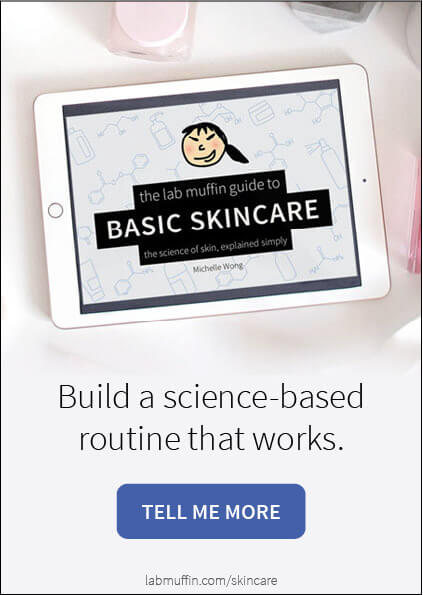


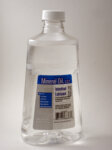
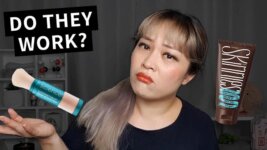
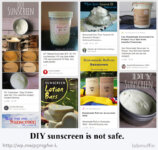
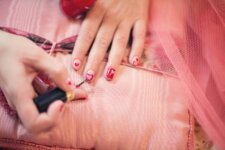
Thank you for another super helpful post! So good to have a more clear idea of which surfactants I should be avoiding (I know my eczema hates SLS!). I really like the sound of the Nivea cleanser, too, I’ll have to see if we can get that over here in the UK 🙂
Jess xo
It’s on the UK Nivea site! 🙂
Michelle you are a hero for posts like these! I think cleansing will be another one of those things people look back on & they’re like WHAT, we used THAT on our skin! I stumbled over a video the other day that showed aestheticians being trained to use UV light treatments to treat back acne LOL
Thank you!
That was super informative! I always learn so much from your posts!
Thank you, I’m so glad you like them! ^_^
I do everything i can to stay away from SLS and as a rule dont use foaming cleansers. Cleansing milks and lotions are my jam!! haha
I still love foam, but I’ve started avoiding SLS and I’m not really missing it much!
Great blog! I love how informative it is.
btw what do you think about micellar water? I have heard some opinions that they are superior to cleansers.
The surfactants are generally gentler but I’ve found that they’re too weak to get off any of my eye makeup. I think if you rinse it off afterwards, or wipe it off with a water-soaked cotton pad they’re quite good, but a lot of people just leave it on which can be damaging since it means the surfactants will have hours to penetrate into the skin!
Thanks!! Not rinsing it off was a mistake of mine;))
Lots of great info in this post! Thanks! I definitely am going to try the Nivea cleanser, I really like Nivea 🙂
Hi! What is the pH of the QV Gentle Wash? Thanks!
pH 6 🙂
Hi labmuffin! I just picked up Vanicream Gentle cleanser. These are the ingredients:
Purified Water, Glycerin, Coco Glucoside, Sodium Cocoyl Glycinate, Acrylates Copolymer, Caprylyl Glycol, Mica, Sodium Chloride, 1,2-Hexanediol, Titanium Dioxide, Sodium Hydroxide, Disodium EDTA
Does that look good to try?? I have dehydrated, combo, congestion/breakout-prone sensitive skin. Thanks!
That looks pretty good – there’s a lot of glycerin and the surfactants aren’t sulfates so it should be quite gentle!
Hey… great post!
Currently I’m using micellar for an initial make-up swipe then a tiny bit of Cerave’s ‘hydrating’ cleanser with luke-warm water. What do you reckon?
Quick additional point.. what about all those beauty gurus who recommend A/BHA acid wipes every time after cleansing? Won’t that also play havoc with the skin’s surface?
That sounds like a pretty gentle routine! Getting the micellar water off your skin after cleansing is definitely a good idea.
It really depends on your skin and how harsh your cleanser is – if your cleanser has a high pH and is quite harsh, an acid wipe afterwards will help restore your skin’s pH, but if it’s gentle it could aggravate it, if you have sensitive skin. If you want to use AHA/BHA after cleansing and you have sensitive skin, plus your cleansing is gentle, then I’d recommend waiting a little for your skin barrier to restore itself before using the acids (freshly washed skin is more permeable so waiting will reduce the intensity of the AHA/BHA treatment).
Hi great post.
Have you done any research/experimentation with oil cleansing?
Thank you! Yes I have:
All About Oil Cleansing: A Beginner’s Guide
Oils for Oil Cleansing – Review
Thanks. I’ve only been experimenting for about 2 weeks now and have definitely noticed a positive difference with my oily T-zone. But my skin has been more dry after so still have to use a moisturiser (that may be because it’s winter!). I’ve tried a mix of castor/jojoba oils and now I’m tying grapeseed oil because I learned that it high in linoleic acid, which is supposed to be better for acne prone skin as our skin tends to be deficient in that acid.
Hey! I’ve just discovered your blog and I love it.
I switch a 3-4 weeks ago from harsh, matifying cleaning routine to one more gentle for normal skins I have noticed the difference. My skin is less oily and with less acne.
I was thinking on switch to an even more gentle routine (because my face is less oily, but still oily) and I was thinking about Caudalie products.
What do you think about this brand products?
I’ve only tried a couple and they were OK 🙂 I do know someone who had a reaction to their micellar water though, but she didn’t rinse it off afterwards and her skin is quite sensitive.
Michelle, I’m absolutely horrified at your use and recommendation of that Antipodes product. I count seven (SEVEN!) fragrance ingredients, and fragrances are potential skin sensitizers. There’s absolutely no good reason to perfume our faces, but one excellent reason not to do it. Given the ingredients list, there’s way more fragrance in it than there is vitamin E and gluconolactone, two ingredients which actually ARE useful in skincare. (cringe) That product doesn’t make a whole lotta sense, and I’m really surprised that you’d even consider putting that on your face. 🙁
The “dangers” of fragrance are very exaggerated by a particular brand who also demonise alcohol – I’ve been meaning to do a post on this, but I haven’t had time!
Hi! 🙂
I saw that japanese women use a net thing to make cleanser foamy, and they wash their face with that foam. Do you know what’s the purpose of it? Beside it may feels good. There is any change in chemical structure what makes it more gentle?
(Sorry for any mistake, I am not a native speaker)
It’s mostly to improve spreading – it won’t change its harshness.
I’m looking at Indie Lee’s Rosehip cleanser and the main surfactant is sodium olivate. Is this too harsh to use on the face? It also contains glycerin and Rosehip oil. It is supposed to be gentle and the pH is low according to what other users have found.
I found the Indie Lee cleanser mild and low PH but it wasn’t for me. I like to use a Foreo device and the cleanser is the texture of a watery gel and it was too runny to use with the cleansing device. If I was just using hands it would have been fine texture-wise. I also didn’t like it really stings near the eye area. Once i got it in my eyes and they were stinging and red for a long time. I prefer to have one product for both face and eyes. Since I don’t wear traditional mascaras or eyeliners there isn’t much reason in my opinion to use a separate eye makeup remover. I returned mine since it didn’t check the boxes I’m looking for.
Hi,
Thanks for your informative post. Is there a cleanser available in the US that is comparative to the QV cleanser? I’d like to find something that doesn’t have alcohol in the ingredients list, as I’ve found that irritates my skin and makes it dry. I like the Nivea product too, but it has alcohol.
Thanks!
Eva
Hi Eva – my vote goes to Cerave…
It foams but is lower ph and there’s a dry/sensitive version, which suits my fussy skin. Its cheap. And it’s annoyingly more available to you in the US than me in the UK!
Hey Michelle! I’ve been scoping out your blog and it is honestly eye-opening when I finally understand the science behind the scary product names in ingredient lists. I am definitely someone who currently tries to avoid SLS, SLES, parabens, artificial fragrances, etc etc etc even though upon reflection (and reading this post), a plethora of products have been really great for my skin, AND contained these products, so I don’t see a need to avoid them anymore and waste money on “safer” products, since I don’t have sensitive skin. What are your thoughts on the Oily Skin Cetaphil?
Great post!!!!!
I learnt a lot!!
Hi, I was wondering if your suggestion of testing a product for two weeks (in your skincare guide) also applies to cleansers.
Loved the post! Always so informative and based on credible, solid science! Quick question though.
It says that multiple surfactants reduce irritation becuz it penetrates less deeper in your skin. Would this be the same for fatty acids that work as surfactants such as myristic, palmitic, stearic, and lauric acid?
Hi. Hope to get answer. I wonder about the sorbitan laurate in the emulsifier. I read sorbitan laurate is an Ester of lauric acid. Lauric acid being very comedogenic does this mean sorbitan laurate also will be?